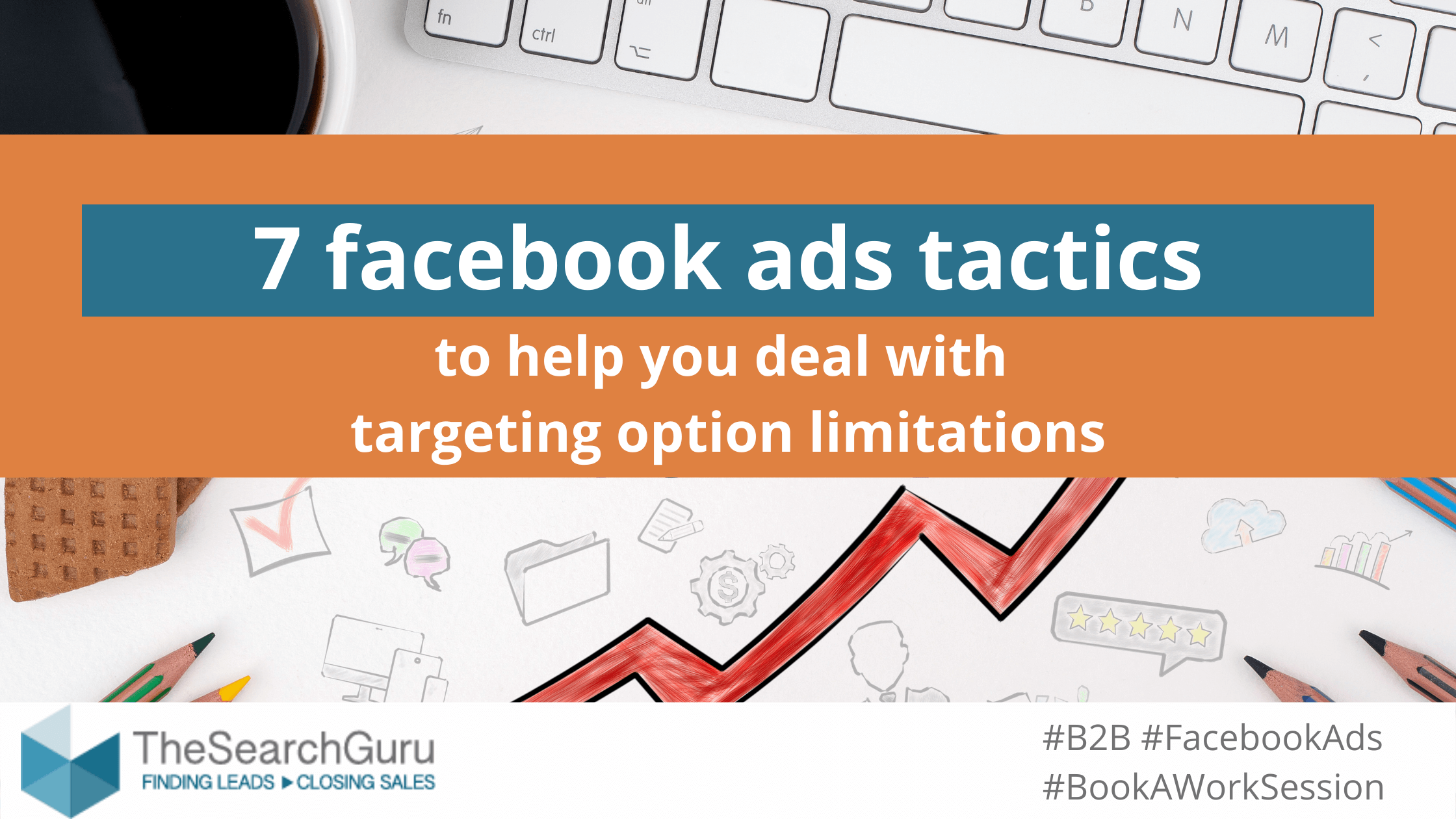How do you know if you’re doing content marketing right? How do you know if you’re creating the right content to fuel the complexities of your sales cycles? Not sure? You’re not alone.
Update May 18, 2020: As a second phase of the “What Works and What Doesn’t Work in Content Marketing” research we are conducting one on one interviews with lead content marketers. The article has been updated with latest findings from these interviews.
Content Marketing Research Highlights: What you’ll find in the article:
- Are Content marketing managers satisfied with their efforts
- Top issues Content marketers and SEO professionals face (and solutions)
- Competitor Research, Content Purpose, Website Goals
Here is a sample of stats you’ll find here:
- 64% of Content marketing managers don’t have enough resources or bandwidth
- Combining issues #2 and #3, 70% of content marketers face challenges in measuring content marketing performance, efficiency and what’s working.
- 22% of marketers surveyed found that content takes too long to show results.
Use these results to benchmark your own process and identify opportunities for improvement, as well as leverage this report’s findings as evidence to make a compelling argument for more resources or process changes at your company.
| About this data: Research Methodology |
|---|
| The survey, “What Works and What Doesn’t in Content Marketing,” was designed to help better understand what content marketing managers were really thinking when it came to their own content marketing. The results we are sharing here are from over 400 senior-level content marketing leaders from both B2B and B2C companies from the period of January – September 2019. (The latest update includes data till May 2020.) |
| The content marketing survey targeted: |
|
Let’s get to it: here’s what we found.
Baseline: Are Your Content Marketing Activities Hitting Your Goals?
Being a content marketer isn’t always easy. At times, it may seem like you are constantly having to explain that content marketing is needed for any business with a long and complex sales cycle, and it takes time to show results. That’s why we started the survey with the question: “Is your content marketing program hitting its goals?”
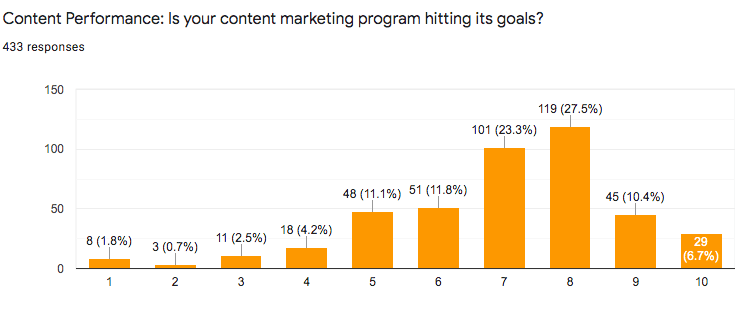
Responses were provided on a scale of 1 to 10, with 1 being the worst and 10 being the best.
The majority of respondents are happy with the results of their content marketing efforts. Nearly 70% selected 7 or higher for their content marketing program hitting its goals.
IMPORTANT: To better analyze the results of answers across the rest of the survey, The Search Guru (TSG) split responses into two groups —
- Group 1 are those who answered below 1-6 (those not hitting their content marketing goals), and
- Group 2 are those who answered 7-10 (those who are having some level of success and satisfaction).
Be aware that many common issues remain across both segments and their content marketing efforts.
The Top 3 Issues Content Marketing Managers Face and How to Solve Them
Three common themes came out of the survey when exploring the main issues and concerns of content marketing leaders. They are as follows:
- Bandwidth – lacking the level of resources to execute against strategy
- Measurement – lack of ability to properly measure against specific performance metrics with efficiency
- Takes too long to see results – Understanding what’s working and what doesn’t work in content marketing based on its extended timeline to see results.
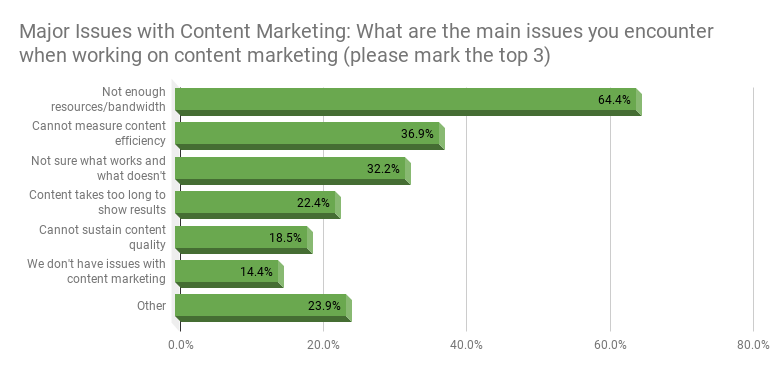
Let’s dig into each of the three problems and provide some solutions to address each of them.
Issue #1: Not enough resources or bandwidth
Our survey found that 64% of content marketing executives lack the resources required or necessary to properly execute against content marketing plans.

Split by groups based on 1st question (Is your content marketing hitting its goals, where 1 is “not at all” and 10 is “100%”),
- 71% of Group 1, (the unsatisfied ones with rankings 1-6) selected the lack for resources as a major issue,
- while only 62% of Group 2 (rankings 7-10) chose it as an issue.
How to Do Content Marketing with Limited Resources: Tips and Solutions
Tip #1 Keep your priorities straight – When you don’t have the resources to “do it all,” prioritizing content marketing activities is essential. In order to prioritize, you need to gather data and analyze it to establish the best course of action. [bctt tweet=”When you don’t have the resources to “do it all,” prioritizing is essential. In order to prioritize, you need to gather data and analyze it to establish the best course of action. #contentmarketing “]
For example: you can look at what type of content is already working for you. Content that brings in the most organic traffic or has the highest click-thru rates and (especially) what converts best can offer valuable insights upon which to build. Do more of what’s working first, to maintain momentum, then expand into new territory.
Tip #2 Optimize processes – Internal processes, if documented correctly and followed by the team, can save a lot of time in both production and onboarding additional resources. When optimizing a process, focus on speed and simplicity. When you find a bottleneck or anything that slows down internal workflows, find a way to fix it, then document and communicate those changes. Continuous optimization is a cornerstone to success.
Tip #3 Go for the quick wins – This is a subsection of prioritizing, but by showing quick results, you’ll be able to ask for more budget for other activities. Here’s an example of how this works when it comes to optimizing content to improve search rankings:
- Identify keywords and pages which rank close to page 1 in Google results (SERPs), but are not there yet.
- Choose keywords that have high search volume
- Optimize the ranking pages for these high volume keywords, so you can push the page higher in SERPs and start earning more free traffic quickly.
Tip #4 Minimize the back-and-forth – If content creation takes too much time to produce with multiple back-and-forth sessions between copywriter and assignee, consider creating Content Plans and Outlines. They will definitely save time for content creation and SEO optimization afterward. Data-driven content planning and outlines include:
- Major keyword to target and related keywords
- Main topic and related topics
- Heading structure of the copy – what sections to include on the page
- Recommendations for additional elements like: Images/videos; call-to-action, infographics, and more.
When you give an assignment for content creation, you should be providing a clear outline what the copy should be about. This outline is done with a little bit of research — check what people search for related to the topic by researching what other pages rank well that cover those same topics and subtopics. Have a plan for the content – main topic, subtopics, keywords to include. That will help your article cover the questions users are looking for and make it possible for the piece to rank in search engines.
“Content Marketing is a long play. It takes time and effort to do it right. You need to keep your audiences’ needs in mind when you plan your editorials. You also need to optimize for search with clear calls-to-action. In addition, you need to understand how your key content pieces map into the overall customer journey. Content marketing is not just to create one piece of content, many puzzle pieces playing into it to make content marketing work.”
– Pam Didner, Founder | VP of Marketing at Relentless Pursuit
Issues #2 & 3: How to measure Content marketing performance
As a Content Marketing manager you’ve been constantly asked about the ROI of content marketing. Our survey found that 70% of content marketers are facing challenges in measuring content marketing performance, efficiency and what’s working.

Here, combining issues #2 (Can’t measure content efficiency) and #3 (Not sure what works):
- 94% of Group 1 (the unsatisfied ones, 1-6) chose them as major issues,
- while in Group 2 (satisfied, 7-10) only 59% chose them as major issues.
This begs the question: What KPIs / metrics do you need to follow to make sure your Content Marketing is working?
Our advice here is: make sure your expectations are correct, then set specific KPIs to measure. For example:
Content Marketing KPI’s to track:
- Leads and conversions – This is the ultimate goal for B2B businesses and must be a core focus for content marketing activities as well.
- Organic traffic – This is the logical outcome of content marketing activities with Search Engine Optimization (SEO) in focus. This may include impressions, clicks and overall ranking from Google Search Console.
- Backlinks – If you’re building valuable content and digital resources that are appreciated by your audience, you should start earning backlinks organically.
[bctt tweet=”Organic traffic and backlinks work together – the higher a content piece is for a high volume search term, the higher the chance is that it gets backlinks. 1/2 #contentmarketing #research”][bctt tweet=”And backlinks will help this content and the website as a whole to rank organically in the search results. 2/2 #contentmarketing #research”]
- Assisted conversions from different channels from Google Analytics
- Conversion rate per landing page
- Bounce rate – When the content is right and the website is well designed for speed, the bounce rate should go down and while the time on site goes up. This is a good sign that you’re doing content marketing right.
How to Measure Results from Content Marketing Activities: Tips and Solutions
Tip #1: Make sure your Goals and Tracking is setup correctly – We constantly check Analytics accounts of clients and prospects and we rarely see Analytics data without issues. Here’re some of the most common ones:
- Not having minor goals: A minor goals is e.g. getting an email; a major goal is making a sale. If you expect users to become clients directly after reading your great article, you are wrong. Instead of trying to convert them right away after just getting to know you, try something simpler, that is just ask for their email address. Make sure your content is optimized for a minor goal — e.g. getting an email.
- Not tracking all important goals: It is common when we ask a client if they are tracking a form or a new webinar signup that they say it’s a recent addition and they are not tracking them yet.
- Make sure the new goals are not forgotten and are being tracked, otherwise you won’t be able to measure the effect of your content marketing efforts.
- Make sure forms you’re using only for the blog articles are added as a goal, so conversions from there are being tracked
Tip #2: Manage expectations, including your own – Do you have the right expectations for content marketing? If you’re doing content marketing, you need to believe in the following statements and need to be explaining them regularly to the management team:
- Content marketing is not a one-off campaign
- It is needed because users do research online
- Content helps improve Domain Authority (DA) which will lead to ranking your higher-value (and better converting) “money” pages higher
- Content helps link building and social media campaigns
“Content marketing is more effective when it connects authentically with the customers; and has a clear and specific goal. Awareness and reaction are helpful, but not essential indicators of success.”
– Stephen Greene, Creative Director of Digital & Content Marketing at 7-Eleven
Content Marketing Benchmark:
- We’ve rarely seen Conversion rate from blog articles above 0.10% (and other experts confirm a similar number) so don’t expect your blog pages to be converting as high as the product/service landing pages.
Issue #4: Long-tail Results
Many marketers struggle with understanding and validating long-term or “long-tail” results, especially as some content marketing strategies take time to prove their effectiveness. In fact, 22% of marketers surveyed found that content takes too long to show results. [bctt tweet=”22% of Content marketing managers surveyed reported that content taking too long to show results is a major issue for them. #contentmarketing”]

How to get faster results from Content Marketing: Tips and Solutions
Tip #1 Start with Quick Wins:
- High-performing content: Identify what works currently for your brand and do more of that
- Low-hanging fruit: Identify low-hanging fruit content (high search volume, position #7-30). Focus on improving these content assets first, as they will bring quick results
- Competitor analysis: Quick ideas what works for competitors will help you prioritize your actions around what your shared target audience is responding most to.
Focus your content marketing and SEO efforts where it is easier to show results. For example, start with keywords and pages, which are ranking pages 2 or 3 in Google results. The keywords are close to page 1, but not there yet and not earning traffic for the brand. So, by expanding the copy on the page, including more topics and keywords, structuring the content in a better way, improving meta information, etc., you have the chance to pull these results to Page 1 in Google SERPs, which equals to more free traffic. You can find those low-hanging fruit opportunities via Google Search Console or tools like SEMrush.
“Don’t underestimate the value of internal linking. I’m amazed at how much quicker and higher a post will rank when you take the time to find and place internal links.”
– Garrett Stembridge, Head of SEO and Content Marketing at Qualtrics
More Findings: Competitor Research, Content Purpose, Website Goals
Competitor Research: What information for Competitors do Content Marketers collect?
The goal of competitor research is to identify and “reverse engineer” winning digital marketing strategies. More than 90% of content marketers surveyed say they review competitors’ activity. In follow-up research, TSG asked for details of what they looked for when researching the competition. Here are the findings (respondents could give more than one answer):
-
- Content they produce – 91%
- Social media activities – 69%
- Homepage changes – 57%
To get the most out of competitor analysis, it should include:
- Top SEO content (top content ranking in search engines)
- Top social media content (getting most engagements)
- Top backlinks content (content that earns backlinks)
- Worth-noting Conversion Rate Optimization (CRO) elements
BONUS: How to research your Competition on Facebook
Do you know which of your competitors are running Facebook Ads? Here’s a way to check:
- By using the Page Transparency section of your competitors’ Facebook Pages, you are able to see very clearly not only if they are running ads, but you can see the actual ads they’re running.
- Keep an eye on your competitors, their messaging, and keep track of what you see.
- Note if the number of ads increases or decreases each month.
- You can make some inferences based on that information, like if they are investing more or less money into the platform.
Content Purpose, Type and Frequency: What type of content is released and how often?
The purpose of content among all marketers surveyed was similar: lead gen; SEO; social; brand awareness, and email.
The type of content produced included: blog articles (
As seen from the chart below:
- almost twice as many marketers from Group 2 (7-10) invested in monthly long form articles
- compared to Group 1 (1-6).
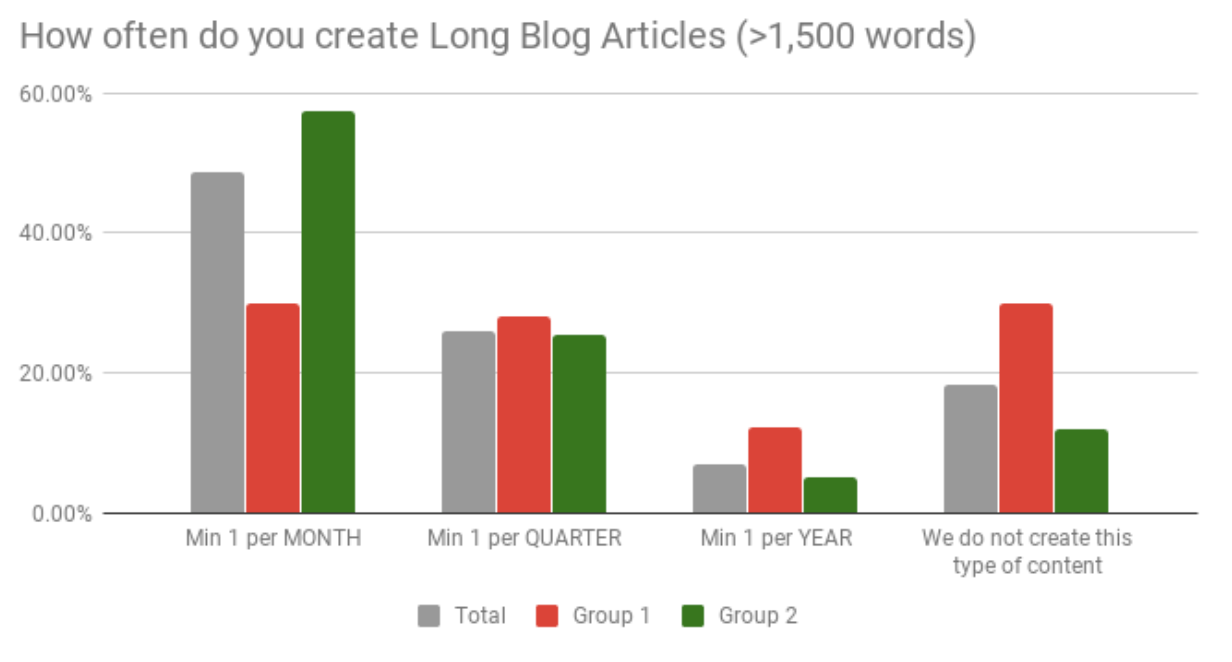
What stood out was the popularity of video content. Videos are even more popular than Case Studies:
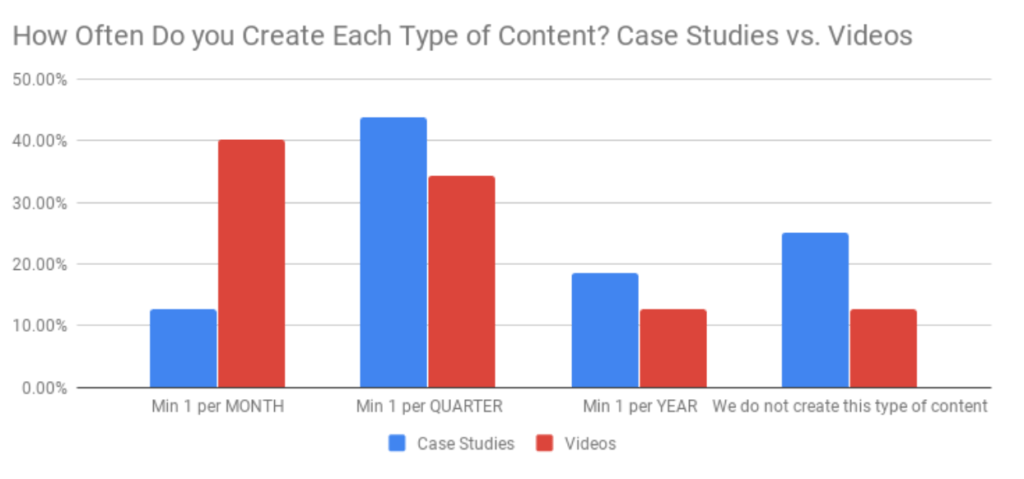
Content marketers shared that videos are created every month (40%) or at least once per quarter (34%) of those surveyed. Less than 13% of respondents do not create videos. What this tells us is that the use of video remains a focus of marketers, and that definition of content must not be limited to the written word nor static image alone. Here Group 1 and Group 2 results do not differ significantly.
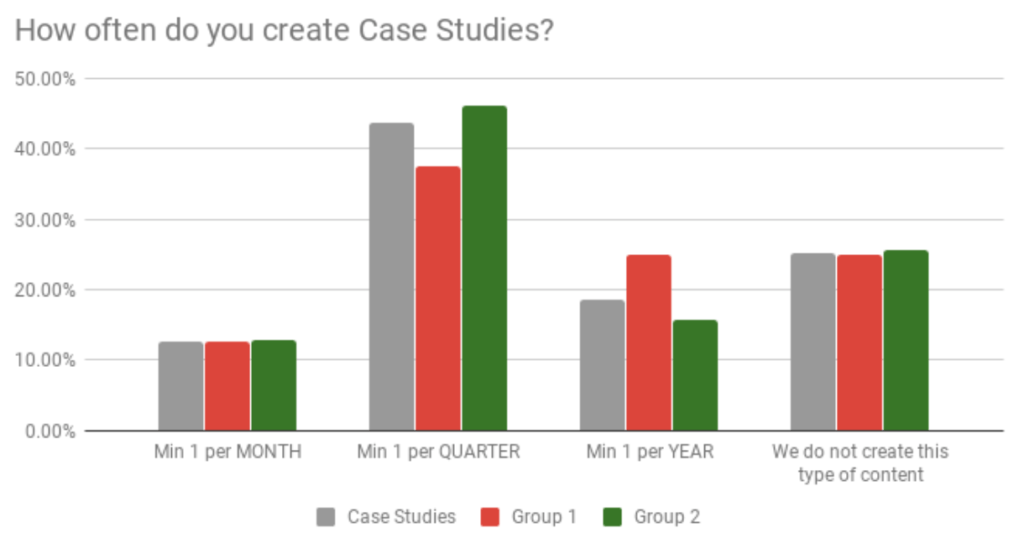
BONUS: The Importance of Optimizing Video
Even if you are hosting your content on YouTube (or other third-party site), you should still optimize the video on your site. You can do this using a video sitemap. This can be part of your main sitemap or a separate, specialty sitemap (recommended).
- Identify a thumbnail, video title, and video description along with where the video can be found.
- By using a sitemap like this, you can see your video show up under “Videos” in search results.
- This will help drive more people to your page versus a third-party video host.
“Meeting the user where they’re at. Use the right content in the right channels, and make sure what you create fits into the user’s expectations for that channel. And, obviously, make sure your content is useful and interesting.”
– Drew Johnson, Senior Manager, Digital Content at McKesson
Goal of Website
While this isn’t directly a content marketing question, your website and content go hand in hand. Having a clear goal for the website will help better define the type of content you require and the purpose it serves. The majority of the content marketers surveyed are focusing on lead gen (65%) vs. transactions/online sales (14%).
![Do you have a clear goal on your website [chart]](https://thesearchguru.com/wp-content/uploads/2020/01/Screen-Shot-2020-01-28-at-8.07.53-AM.png)
Pro tip: One of the best and easiest content marketing ideas for companies (both B2B and B2C) that offer user customer support is to turn their ticketing/support communication into website content. Make the questions customers ask and the answers the support team provides available for search engine crawling. The best part is that the content is already available and just needs a little polishing. It is what customers are asking for, so the probability that others are interested in the same content is high. Also, by providing answers to tricky questions, you’ll earn the trust of your audience.
What Works Best: Patience plus Persistence
While most people agree that content marketing is an important component to any modern marketing strategy, what works best and how it is best executed is often unique to each business. Maintain a focus on the customer — what information they want or need, when they need it, and how they prefer to consume it.
Content marketing can be measured by the organic traffic it brings to your website, by the backlinks and social engagement you’re getting, and by the overall growth of your business. Content marketing is not a one-off campaign, which you can create, run and then measure its effect. Content marketing takes time, but its results are exponential. New content is supported by old content, which then in turn can bring new life to old pieces, causing a jump in site traffic.
“Patience and perseverance are essential. Content marketing is about slow, sustained growth, not immediate results. Be patient. And through your journey you will run into opposition, whether it is to the nature of the content, the resources it consumes or something else. Don’t roll over as soon as you experience pushback. State your case and stay the course.”
-Jeff Dusing, Senior Manager, Digital Marketing and Content at WillScot
Continuing the Research: How You Can Help
The survey by the team at TSG is continuous. Additional findings will be published in the coming quarters, as well as presented at Content Marketing World 2020. If you are a content marketer and would like to contribute to the research, click the link below to fill in the survey (estimated 7 minutes to complete): https://thesearchguru.com/content-marketing-research/. Thank you!
Conclusion:
After reading through this article you can get a sense of which of your approaches, processes or expectations may need modifying and which opportunities may be present. There’s no universally right or wrong answer; it’s highly dependent on the specifics of your brand and your target audience. But knowing general trends and preferences can help you shape your strategy so it’s as effective as possible.
Let’s work on this together: book a free work session
All companies we speak with have unique problems, and we’ve yet to find anyone who isn’t primarily plagued by too few resources. Take us up on a free training/work session where we can discuss your unique problems and offer solutions from top B2B marketers. Book one here:






